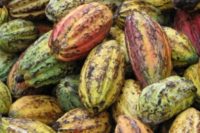
|
| Photo provided by Hershey. |
It’s not hard to figure out that if Mars, Nestlé, Mondelez and Ferrero and Hershey all are planning to use 100 percent sustainable cocoa by 2020, then the world is going to need more sustainable cocoa.
Which is why The Hershey’s Co. hasn’t been shy about expressing the need for chocolate companies to work together to help cocoa farmers around the world. And it’s new 21st Century Cocoa Plan goes right along with that.
The company describes the plan, unveiled today, as “a roadmap for how the company will work to help cocoa communities around the world grow sustainable cocoa for the next century.”
“Cocoa is at the heart of our business and we care deeply that this key ingredient is grown in a safe, healthy and sustainable manner,” says John P. Bilbrey, The Hershey Co.’s president and ceo. “This is a watershed moment for our industry to work together with cocoa growing nations to increase opportunities for farmers through better training, financing and community development. The complexity of the challenges requires us to work together with a focused plan.”
Specifically, the plan, looks at what Hershey can do to help cocoa farmers and how it’s doing at reaching it’s own goals.
For example, it outlines the fact that The Hershey Co. is hoping to get at least 10 percent of its cocoa from certified sources by 2013 — one year after announcing its 2020 goal.
It’s also on track to source about 40 to 50 percent sustainable cocoa by the end of 2016; and then eventually reach its ultimate goal of 100 percent by 2020.
Hershey has already committed to sourcing cocoa through UTZ, Fairtrade USA and Rainforest Alliance. As Hershey’s buying volume increases, the company will be working with other well-established certification organizations to expand their capacity to certify more cocoa farmers globally.
The 21st Century Cocoa Plan also outlines Hershey’s plans to accelerates its CocoaLink program, which supplies mobile phones to cocoa farmers and then delivers agricultural and social training to them at no cost. In 2013, the program will expand into Cote d’Ivoire, after launching in Ghana in 2011.
Hershey also will work more closely with its Learn to Grow Farmer and Family Development Center, launched in Assin Fosu in Gahan’s central cocoa region.
The center, created in partnership with Source Trust, a non-profit organization set up to help farmers improve their livelihoods through better crop yields and quality, will provide Hershey with verified cocoa that can be traced back to the individual farm level.
There are also a range of on-the-ground programs and initiatives that work together to accelerate positive change in the cocoa growing regions over the next seven years.
For example, in Mexico, Hershey and cocoa supplier Agroindustrias Unidas de Cacao SA de CV have launched the Mexico Cocoa Project, a 10-year initiative to reintroduce cocoa growing in southern Mexico and help restore the country’s cocoa crop after it had been nearly decimated by the spread of a disease known as frosty pod rot.
Through the distribution of disease-tolerant trees, the program intends to improve the livelihoods of more than 1,000 cocoa farmers and their families in the region and quadruple family incomes.
Through its own and partner programs, Hershey estimates the total portfolio of programs encompassed by its 21St Century Cocoa Plan will directly impact 750,000 cocoa farmers and indirectly benefit more than two million West Africans through utilization of technology, farmer training on good agricultural practice, cocoa seed nurseries and planting material, farm inputs on credit, village resource centers, malaria prevention, community infrastructure, village school construction, and literacy and health programs.
Hershey will regularly update its progress on the Hershey’s 21St Century Cocoa Plan and its various programs through its Corporate Social Responsibility public reporting and on its website.










